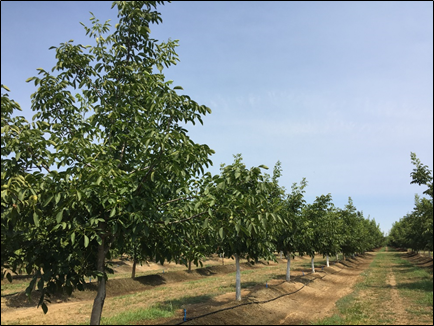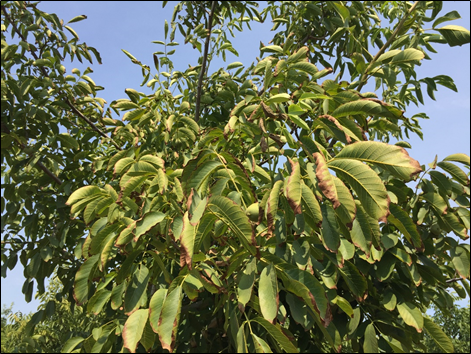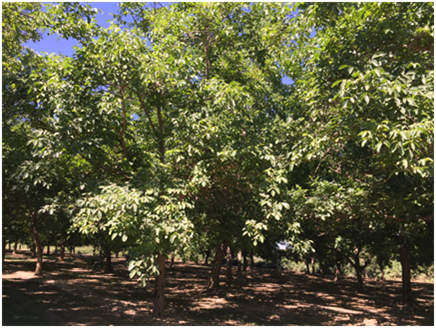Janine Hasey, UCCE Farm Advisor, Sutter/Yuba/Colusa Counties, Greg Browne, USDA Plant Pathologist, UC Davis, Astrid Volder, Plant Sciences, UC Davis and Bruce Lampinen, UCCE Walnut Specialist, UC Davis
2017 brought unprecedented high and fluctuating water flows in the Sacramento and Feather Rivers, damaging orchards from direct flooding and indirectly via under-levee seepage. Many trees had a long exposure to waterlogged conditions through the winter and spring. With this extensive flooding, we expected to see effects through the 2018 season in several orchards. Previously, we reported on results from sampling trunk cankers for Phytophthora and roots in a waterlogged young orchard, and key factors/conditions leading to survival or mortality of flooded trees based on observations; all previous walnut flooding articles are available here. This article details completion of sampling and observations of disease, survival and recovery in 2018, as well as recommendations to minimize losses in flood-impacted orchards.
Research Results and Observations
Flooding results in two potential problems: 1) Phytophthora diseases and 2) waterlogging impacts (oxygen starvation) on the root system.
- 2018 Phytophthora. Partially submerged for prolonged periods in 2017, walnut trees affected by aerial Phytophthora in Feather River bottoms were revisited in 2018.
- Water sampling: Since we know the “water mold” Phytophthora is found in surface water and infested soils, we sampled water in the Feather River in two locations in 2018. Several Phytophthora species were identified.
- Tree trunk samples: Phytophthora citricola was isolated from bleeding trunk cankers sampled in June. Aerial trunk cankers (Fig. 1) began healing by June and July. Trees differed in severity of infection.
- Most trees with aerial Phytophthora had healthy canopies this summer (Fig. 2) and unless trees were declining, new tissue was forming around cankers by June and July (Fig. 1).
- Waterlogging impacts from long-term seepage (January to May 2017) on walnut root health and recovery.
- Root sampling from flooded trees in a fourth leaf Chandler orchard on RX1 rootstock; trees leafed out about a month late while most failed to push by end of June 2017.
- Soil cores to a 3 foot depth were collected on June 29, 2017 when trees on higher ground outside of the seepage area had fully leafed out. Standing water was found at a 25” soil depth in the seepage zone.
- We compared root length distribution of Chandler trees on higher ground (control) to those of trees failing to push in the seepage zone (photos in Spring 2018 issue).
- Seepage zone Chandler trees that did not push had much lower standing root length in the top 2 feet than control trees (~5 km roots/m3 soil vs ~15 km roots/m3 soil). Failed trees had much coarser roots, suggesting they either produced no new fine roots or their fine roots had a much higher mortality rate. New fine roots generally contribute most to soil exploration and water and nutrient uptake.
- For many orchards, the extent of flood damage was not evident until 2018. Trees often died or declined in a random pattern, or, they died in areas with shallower water tables or longer periods of flooding.
- In a 12-year-old orchard with prolonged surface seepage from the Sacramento River, random unhealthy trees were marked in 2017. These trees were topped in May 2018 and photo documented monthly (Fig. 4). Unhealthy trees had crown gall suggesting roots were already compromised before flooding; trees with more severe crown gall did not respond to topping with new shoot growth. Trees without crown gall were growing well a year after flooding.
Recommendations to minimize losses in flood-impacted orchards:
Trees infected with aerial Phytophthora:
- We advocate keeping these trees as long as they are economically productive.
- In previous research, phosphonate (also known as phosphite) treatments were found to suppress canker expansion caused by Phytophthora citricola. All orchards we resampled had phosphonate sprays applied in 2017 and 2018 which may have contributed to the new tissue forming around cankers.
- It is advisable to replace trees killed by Phytophthora with clonal Paradox RX1 rootstock, which offers resistance to the pathogen. When planting new walnut orchards in flood prone river bottoms, consider using potted RX1 trees and field budding or grafting as high as possible to avoid aerial Phytophthora infections from future flood events.
Trees affected by waterlogging:
- In saturated soils, fine roots die, and depending on the extent of flooding, larger roots can die as well. It takes time for the root system to regain functionality and re-start new fine root production after flooding.
- Consider topping trees with vigorous shoot growth on lower limbs. From grower experience and 2018 observations, these trees often recover by producing new shoot growth. It was obvious as early as June this year whether a topped tree will respond and grow or not. By contrast, trees that have very little new shoot growth often don’t survive the season after flooding so topping is unlikely to promote tree survival.
- Irrigation: Keep in mind that flooded orchards are most likely dealing with a shallower, less developed root system than in previous years. Some orchards re-flooded in 2018 and/or those continuing to have a high water table created a difficult situation since root growth on surviving trees was rebounding from root death last season. Figure 5 shows the response of 2017 flood damaged 5-year-old trees that were either topped in May 2017 (trees with white trunks) vs. a less affected tree in the foreground that had little pruning. All trees were growing well but in July 2018, many trees showed scorched outer leaf symptoms indicative of too much water from overirrigating with a high water table (Fig. 6).

Figure 5. July 2018 growth response of 2017 flood damaged 5-year-old trees that were topped in May 2017 (trees with white trunks) vs. a less affected tree in the foreground that had little pruning. Photo credit – Janine Hasey.

Figure 6. Scorched outer leaf symptoms in same flooded orchard in July 2018 indicative of too much water due to over irrigating with a high water table. Photo credit – Janine Hasey.
- Where water tables remain high, consider the following points:
- Capillary rise is the process by which water moves up into soil above a water table resulting in soil in this zone being above field capacity. In medium loam to fine clay, expect approximately 3 feet of capillary rise. The finer the soil texture the farther up water can move by capillary rise but the slower the rate of movement.
- It is easy to saturate the soil, particularly when the water table is close, so irrigate judiciously, ideally using both soil moisture monitoring and plant pressure chamber data to aid in determining irrigation duration and frequency.
- Water management in such settings is very difficult. Carefully monitor soil water levels using Watermark® or other soil moisture sensors installed at different depths. Soil-based monitoring will let you know the level where the soil is saturated as the water level drops, as well as the amount of water that is being moved up above this level of saturation by capillary rise.
- When using pressure chamber measurements, do not irrigate until trees are at least 2-3 bars below the fully watered baseline (more dry) and only irrigate enough to bring the trees back up to about 1 to 1.5 bars below the baseline by applying short sets of irrigation. If the baseline is -4 bars, you should reach -5 to –5.5 bars immediately after irrigation. Be aware that pressure chamber measurements may not be appropriate where roots have been compromised, as the observed water stress in the tree may be the result of the inability of the root system to take up water rather than low water availability in the soil. Irrigating under those conditions would only serve to compromise the root system further.
- Where trees have been topped or have new shoot growth, apply nitrogen fertilizer in small amounts during May through early August when roots are active. Topped trees will have little or no crop until the following year so little nitrogen is being removed.





Leave a Reply